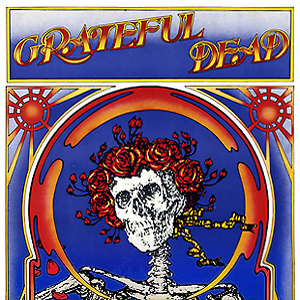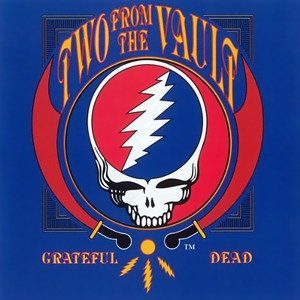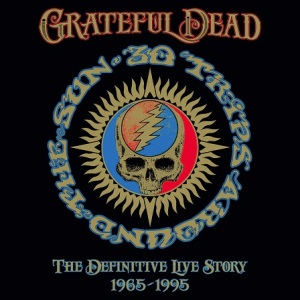
Anthem of the Sun is the second album by rock band the Grateful Dead, released in 1968 on Warner Bros/Seven Arts. It is the first album to feature second drummer Mickey Hart. The band was also joined by Tom Constanten, who contributed avant-garde instrumental and studio techniques influenced by composers John Cage and Karlheinz Stockhausen. The album was assembled through a collage-like editing approach helmed by members Jerry Garcia and Phil Lesh, in which disparate studio and live performance tapes were spliced together to create new hybrid recordings. The band also supplemented their performances with instruments such as prepared piano, kazoo, harpsichord, timpani, trumpet, and güiro. The result is an experimental studio amalgam that is neither a pure studio album nor a live album.

Aoxomoxoa is the third studio album by the Grateful Dead. It was one of the first rock albums to be recorded using 16-track technology. The title is a meaningless palindrome, usually pronounced.

Grateful Dead is a live album by rock band the Grateful Dead. Released on September 24, 1971 on Warner Bros. Records, it is their second live double album and their seventh album overall. Although published without a title, it is generally known by the names Skull and Roses and Skull Fuck. It was the group's first album to be certified gold by the RIAA and remained their best seller until surpassed by Skeletons from the Closet.

Fillmore West 1969: The Complete Recordings is a 10-CD live album by the rock band the Grateful Dead. It contains four complete concerts recorded on February 27, February 28, March 1, and March 2, 1969, at the Fillmore West in San Francisco. The album was remixed from the original 16-track concert soundboard tapes. It was released as a box set in November 2005, in a limited edition of 10,000 copies.

Two from the Vault is a three-CD live album by the rock band the Grateful Dead. It was recorded at the Shrine Auditorium in Los Angeles, California on August 24, 1968. The event was left unreleased for nearly 25 years, before being mixed down from the original multi-track reels and released on Grateful Dead Records in 1992.

History of the Grateful Dead, Volume One is a live album by the Grateful Dead. It is their fourth live album and their ninth album overall. Released in July 1973 on Warner Bros. Records, it offers concert highlights recorded February 13 and 14, 1970 at the Fillmore East in New York City. Often known simply as Bear's Choice, the title references band soundman Owsley "Bear" Stanley. It was originally intended to be the first volume of a series.

Live at the Fillmore East 2-11-69 is a double live album by the Grateful Dead recorded during the Live/Dead tour on February 11, 1969, at the Fillmore East in New York City. The first disc represents the early show that night, the second the late show. The Dead opened for Janis Joplin. This album contains the first Grateful Dead CD release of the Beatles' "Hey Jude".

Dick's Picks Volume 16 is the 16th live album in the Dick's Picks series of releases by the Grateful Dead. It was recorded on November 8, 1969 at the Fillmore Auditorium in San Francisco, California. It contains the first live performance of "Cumberland Blues". There is a monologue by someone not in the band during the song "Caution" shortly before the segue to "The Main Ten," who has never been definitively identified.

Road Trips Volume 2 Number 2 is a two-CD live album by the American rock band the Grateful Dead. The sixth in their "Road Trips" series of albums, it was the first to contain a complete concert—the February 14, 1968, show at the Carousel Ballroom in San Francisco, California. Bonus material on Disc 1, as well as the bonus disc offered to early purchasers, comes from the Grateful Dead and Quicksilver Messenger Service "Tour of the Great Pacific Northwest", immediately preceding the Carousel Ballroom show. The album was released on March 21, 2009.

The Warner Bros. Studio Albums is a box set of five vinyl LPs by the rock group the Grateful Dead. It is a reissue of their first five studio albums: The Grateful Dead (1967), Anthem of the Sun (1968), Aoxomoxoa (1969), Workingman's Dead (1970), and American Beauty (1970). These albums were originally released by Warner Bros. Records. The box set was released by Rhino Records on September 21, 2010.

Dave's Picks Volume 3 is a three-CD live album by the rock band the Grateful Dead. It contains the complete concert recorded on October 22, 1971 at the Auditorium Theatre in Chicago, Illinois, with bonus tracks from the previous night's show at the same venue. It was released on August 1, 2012.

Dave's Picks Volume 6 is a three-CD live album by the rock band the Grateful Dead. It contains two complete concerts: one from December 20, 1969, at the Fillmore Auditorium in San Francisco and the second from February 2, 1970, at the Fox Theatre in St. Louis. It was produced as a limited edition of 13,000 numbered copies, and was released on May 1, 2013.

Dave's Picks Volume 10 is a three-CD live album by the rock band the Grateful Dead. It contains the complete concert recorded on December 12, 1969, at the Thelma music venue in Los Angeles, California. It was produced as a limited edition of 14,000 numbered copies, and was released on May 1, 2014.

30 Trips Around the Sun is an 80-CD live album, packaged as a box set, by the rock band the Grateful Dead. Announced for the celebration of their 50th anniversary, it consists of 30 complete, previously unreleased concerts, with one show per year from 1966 through 1995. Comprising 73 hours of music, the box set is individually numbered and limited to 6,500 copies. It was released on October 7, 2015.

30 Trips Around the Sun: The Definitive Live Story 1965–1995 is a four-CD live album by the rock band the Grateful Dead. It contains 30 songs recorded in concert—one from each of the years 1966 through 1995—plus one song recorded in a 1965 studio session. All of the tracks are selected from the 80-CD box set 30 Trips Around the Sun, which contains 30 previously unreleased complete shows. The album was released on September 18, 2015. A chronological sampling format was also used for the 5-disc set So Many Roads (1965–1995).

Shrine Exposition Hall, Los Angeles, CA 11/10/1967 is a live album by the rock band the Grateful Dead. A three-disc vinyl LP, it contains the complete concert recorded on November 10, 1967 at the Shrine Exposition Hall in Los Angeles, California. It was released by Rhino Records in January 2016, in a limited edition of 6,700 copies. The concert was recorded on an 8-track multitrack recorder and was mixed down to stereo for the album.

July 29 1966, P.N.E. Garden Aud., Vancouver Canada is a live album by American rock band the Grateful Dead. It contains the complete concert recorded at the PNE Garden Auditorium in Vancouver, British Columbia, on July 29, 1966. It also includes four songs recorded at the same venue on the following day. It was produced as a two-disc vinyl LP in a limited edition of 6,600 copies. It was released on April 22, 2017, in conjunction with Record Store Day.

Fillmore West 1969: February 27th is a live album by the rock band the Grateful Dead. As the name suggests, it was recorded on February 27, 1969, at the Fillmore West in San Francisco. It was produced as a four-disc vinyl LP, in a limited edition of 9,000 copies. It was released on April 21, 2018, in conjunction with Record Store Day.

Lyceum Theatre, London, England 5/26/72 is a four-CD live album by the rock band the Grateful Dead. It contains the complete concert recorded at the Lyceum Theatre on May 26, 1972 – the last show of the band's Europe '72 tour. It was released on July 29, 2022.

Lyceum '72: The Complete Recordings is a live album by the rock band the Grateful Dead. Packaged as a box set of 24 LPs, it contains four complete concerts recorded at the Lyceum Theatre in London on May 23, 24, 25, and 26, 1972. It was released on July 29, 2022, in a limited edition of 4,000 copies.




















